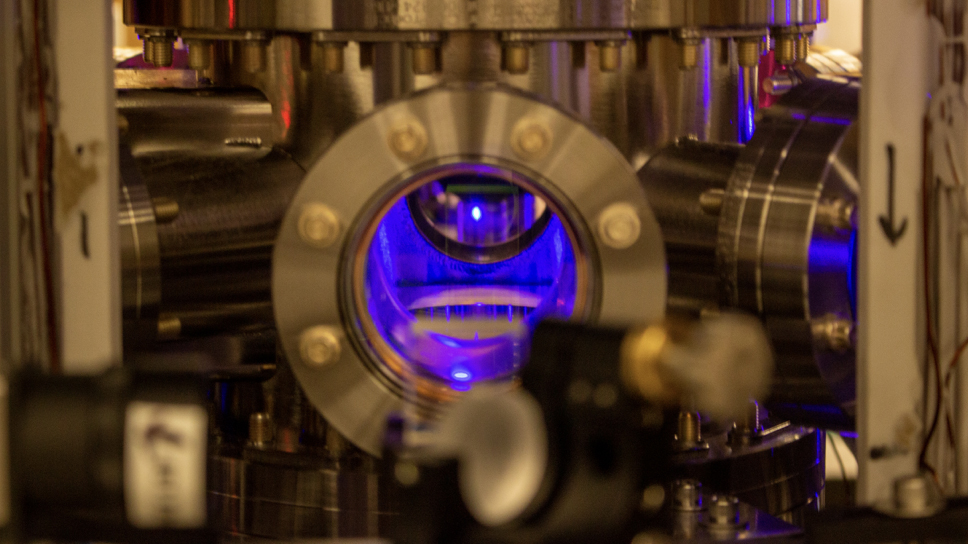
Using one of the world's most precise atomic clocks, physicists have shown that time runs a tiny bit slower if you change your height above the Earth's surface by a minuscule 0.008 inch (0.2 millimeters) — roughly twice the width of a piece of paper. The finding is yet another confirmation of Albert Einstein's theory of relativity, which predicts that massive objects, like our planet, warp the passage of time and cause it to slow down.
"We're talking about measuring a change in how a clock ticks at a level a little larger than a human hair," said Tobias Bothwell, a graduate student in physics at JILA, which is run by the National Institute of Standards and Technology (NIST) and the University of Colorado.
In 1915, Einstein showed that anything with mass will distort the fabric of space-time — an effect we experience as the force of gravity. You can think of gravity as putting the brakes on the flow of time. This mind-bending idea means that clocks nearer to Earth run slow compared with those farther from it — a phenomenon called time dilation.
Related: 8 ways you can see Einstein's theory of relativity in real life
Researchers have already shown that super-precise atomic clocks flown on airplanes run appreciably faster than those on the ground, according to the textbook "Experimental Tests of the Nature of Time" (Fullerton College, 2020). In 2010, scientists set a new record by measuring the passage of time with two aluminum-based atomic clocks separated in height by about 1 foot (33 centimeters), finding that the higher one ran slightly faster, Bothwell said.
This latest measurement is about a factor of 1,000 better, he added. "We've really blown the doors off how well we can measure frequency," Bothwell said.
The experiment used a collection of roughly 100,000 atoms of the isotope strontium 87, which is often used in atomic clocks, cooled to a fraction of a degree above absolute zero and placed in a structure known as an optical lattice. An optical lattice uses intersecting beams of laser light to create a landscape of peaks and valleys resembling an egg carton, where each atom is cradled in one of the valleys, according to NIST.
Sign up for the Live Science daily newsletter now
Get the world’s most fascinating discoveries delivered straight to your inbox.
Each strontium atom oscillates back and forth, ticking by itself inside its valley 500 trillion times per second, like the pendulum of a microscopic grandfather clock, allowing the team to measure fractions of a second to an incredible 19 decimal places, according to a 2018 article in the journal Proceedings of the National Academy of Sciences.
The strontium atoms in the optical lattice were arranged in many layers, kind of like a stack of pancakes, Bothwell said. By shining a laser on the layers, he and his colleagues could measure how quickly the atoms in each layer ticked.
"As you go from top to bottom, you see each layer dancing a little differently thanks to gravity," he said. The findings were published Feb. 16 in the journal Nature.
"These kinds of clock experiments can shed light on the nature of time itself," said Mukund Vengalattore, an independent atomic physicist who was not involved in the work.
That's because the strontium atoms are capable of being placed in what's known as a superposition of states, meaning two states at once, he added. According to quantum mechanics, particles can exist in two locations (or states) at once, so future experiments might place a strontium atom in a superposition where it is located in two different "pancakes" at the same time, Vengalattore said.
With the particle in both places at once, the team could then measure the passage of time at different points along the superpositioned strontium atom, which would change thanks to the different gravitational force it feels. This should show that "at one end of the particle, time is running at one speed," Vengalattore said. "And at the other end, it's running at a different speed."
This incredibly bizarre possibility gets at the heart of the difference between the quantum and classical worlds, he added. Classical objects, like tennis balls and people, can't exist in superpositions where they are located in two places at once. But where the switchover between quantum and classical happens is unclear. By increasing the distance between the pancakes, researchers could essentially make the particle grow larger and larger and potentially see when it stops behaving like a quantum particle and more like a classical one.
Such experiments may allow physicists to get closer to a long-sought dream — a theory of everything that would unify Einstein's theory of relativity, which describes the very large, with quantum mechanics, which describes the very small.
Meanwhile, the current experiment has helped the team envision ways to produce atomic clocks that are even more precise, Bothwell said. Future instruments could be used to measure tiny differences in the mass of the Earth beneath them, potentially making the clocks useful for detecting the flow of magma inside volcanoes, changes in meltwater inside glaciers or the movement of our planet's crustal plates, he added.
Originally published on Live Science.
Editor's note: This article was updated to indicate that atomic clocks flown on airplanes run appreciably faster (not "slower") than those on the ground.

Adam Mann is a freelance journalist with over a decade of experience, specializing in astronomy and physics stories. He has a bachelor's degree in astrophysics from UC Berkeley. His work has appeared in the New Yorker, New York Times, National Geographic, Wall Street Journal, Wired, Nature, Science, and many other places. He lives in Oakland, California, where he enjoys riding his bike.










